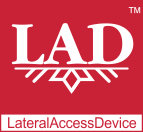
LateralAccessDevice
takes you back to before the Internet
How It Works | Download LAD | Support | LAD Security | Features & Uses | Resources | Members | User Guide
When Your Digital Assistant Moonlights for Someone ElseSiri, Alexis and… Bob. We all know the names of the most popular digital assistants from Apple, Amazon and others, but what about Bob? Yeah, Bob: the guy who spies on you through your digital assistant. Didn't you know that your digital assistant could moonlight for someone else? Your digital assistant is just like your computer: useful, but it can do a lot of things that you don't know about (and wouldn't want it to do). Bob knows this, too. And now he knows all about you, too, from your favorite pizza place to that weird spot that appeared on your foot last week that you emailed your sister about. Oh, and he may know where you bank, too. Your digital assistant is always on, listening, and so is he. While it may be (somewhat) amusing to think about "Bob" listening in, it's not purely a joke. Many companies that provide digital assistants have been shown to collect data on their customers, gleaned through their customer's own digital assistant in their very own home or office (so much for privacy). While you could trust that such data collection is limited in nature and is processed in such a way that no one could trace your data back to you, do you really trust a large multinational corporation to always do the right thing? Especially when there is money to be made? So, what can you do? While you could do without your digital assistant, do you want to? If the answer is yes, then no need to read further — you already have your answer. If you still want to use your digital assistant, yet minimize the risks it poses to you and your data, your best option is not to tinker around with its settings in hopes of making it not collect or share the data you don't want it to, but rather to limit where and when our digital assistant can connect to external locations on the Internet (or internal locations on your computer network, for that matter). If your digital assistant cannot connect externally to wherever it wants in order to surreptitiously send your data to third parties, it cannot send it. It's as simple as that. With IPCopper's LateralAccessDevice you can accomplish precisely this: first see what data and communications your digital assistant is sending out and where to, then simply block off those destinations that you don't want to receive your data. Today we have a wide range of Internet-connected technology available for various purposes: entertainment, work, research, HVAC control, education and even door locks and security systems. Just like with your digital assistant, each of these Internet-connected devices has sensors, memory and processing power — they are all mini-computers that can do what you intend them to do, but they can also do what you do not intend them to do. While carefully choosing which of these technologies you bring into your home or office is always a good idea, it cannot save you from the dangers inherent in having minicomputers with audio and video recorders all over the place, when you cannot actually see what they are doing or with whom they are communicating or when. IPCopper's LateralAccessDevice provides the tools and visibility for you to discover and decide for yourself what you want to allow these devices to do and communicate to others. Download LAD | Learn More About LAD | LAD for Home | LAD for Business | DIY VoIP PBX
|